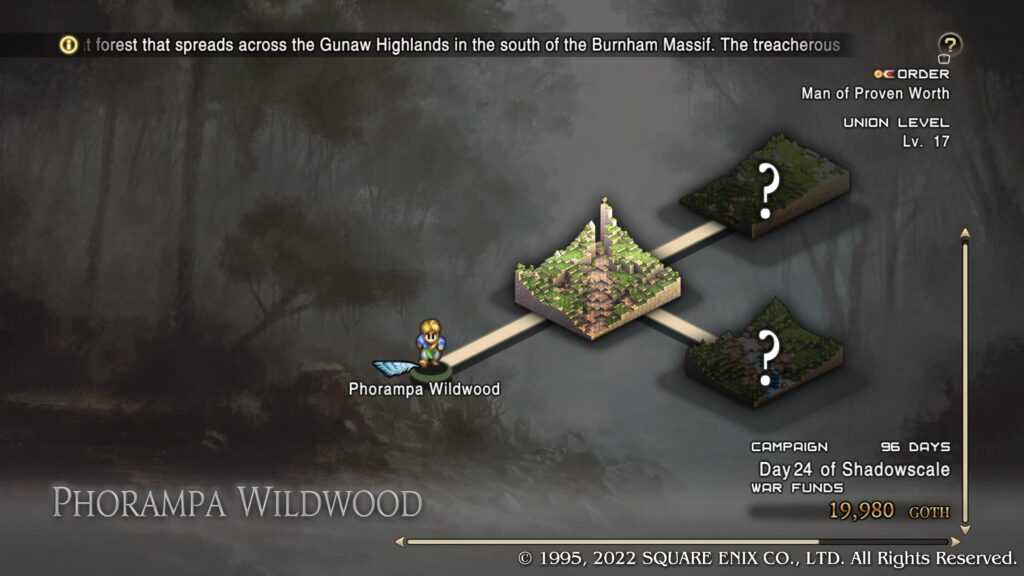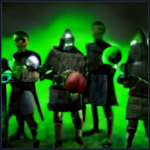Tactics Ogre Reborn is a remake of 2010’s PlayStation Portable release of Tactics Ogre: Wheel of Fortune, itself a remake of an earlier release for the Super Famicon (Tactics Ogre: Let Us Cling Together) that was later ported to the PlayStation and the Sega Saturn. This is a game that’s been around for a long time, but has been overshadowed in the West by its more famous cousins, Final Fantasy Tactics and the Fire Emblem series.
Tactics Ogre: Let Us Cling Together (itself a sequel to the earlier Ogre Battle: March of the Black Queen) was the first tactics RPG to bring together elements that have come to define the whole genre: isometric, turn-based RPGs with no exploration, multiple endings, intricate plots, and complete control over the training and equipping of your growing army, including many classes unlocked during gameplay.
Characters are represented as small sprites in battle. Unique characters get unique sprites, while the rest of the army changes sprite depending on their gender and profession. In conversation, or in their character screen, you’ll see their full portrait, along with their other stats.
As in the other games in the “Ogre” series (Ogre Battle: March of the Black Queen and Ogre Battle: Knight of Lordly Caliber), each character can carry a limited number of consumables with them into battle. These can include healing herbs, status cures, or other useful things. There’s only four slots in this game — there were more in the other games. Kinda missing those extra slots.
Items are automatically restocked after each battle, if there are enough in the inventory to do so. They cannot be restocked mid battle.
Magic
Many character classes can use magic. All magic is elemental, and each character has an element. Magic of an element matching its caster is more powerful; cast against an enemy whose element is weak to the spell element is even more powerful. The tactical strategy pervades every bit of the game. If you find a character would be better with a different element (for instance: healers should be Light based to power their divine spells), you can use charms that can be bought or dropped to realign your characters. I haven’t yet found any charms that can change a unit to Light or Dark, though, so it might be best to go looking for units with those elements to recruit or hire for your healers and terror knights.
The spells themselves may be dropped or purchased, and not all caster classes can use all spells. The only spell Knight Denam gets is a minor heal, and given in my game he is air based, it’s a weak heal indeed.
Skills
Skills are the bread and butter of the character class. Weapon skills power up with usage, being very important for physical attackers. At certain weapon skill levels, finishing moves specific to that weapon become available. For physical attackers, building characters around powering up those finishing moves quickly is key to success. Weapon skills are far less important for magical units.
Defending classes get skills that slow or prevent enemy movement, prevent them from taking damage and so on. A Knight can single-handedly control a choke point on the battlefield with essentially permanent survivability, and the cost of not doing all that much damage.
Berserkers, as a counter example of a class with almost no defense, can partner up with a Knight to provide that crazy damage to enemy units that are being held in place by the Knight.
These sorts of synergies — class with class, element with element — are the core gameplay of Tactics Ogre Reborn.
The plot starts with the hero, Denam, along with his sister, Clariuta and his friend, Vyle lashing out against a crew of enemy mercenaries that have just entered town. Realizing a case of mistaken identity, the trio join up with the mercenaries (all refugees from the previous game in the series) and become members of the resistance, fighting against the Gargastan empire that is trying to wipe out the Wisterian natives.
Decisions made along the way may see you becoming loyal and important members of that resistance, or perhaps a band of renegades fighting the resistance for a better chance of peace with the empire. Your actions may have certain NPCs live, die, or join your army, and all those decisions, good or bad, will be shown on the plot map.
After the end of the game, players can return to any particular point on the map and choose to let the plot play out differently — every regretful decision can be fixed.
There are three endings, Law, Chaos and Neutral. Lawful doesn’t mean good, it means you will do as you are told no matter the order. And chaos doesn’t mean evil, either. The decisions you make, including whom to save and whom to let die, have incredible repercussions throughout the plot.
The descriptions for each NPC change depending upon how they see you in that moment. It’s just incredibly dynamic.
The choice in the picture above is to whether or not to slaughter some refugees who have refused to join the resistance, in the hopes that, by blaming the genocide on the enemy, the nation will be enraged enough to rise up in battle. What if you knew that, no matter your decision, those people were going to be killed, but at least this way, you might be able to set your nation free? And be a hero to your people? And get all the best units? All… all you have to do is kill a few dozen helpless refugees who didn’t like you anyway.
Tactics Ogre is full of decisions like this. What you decide is who you become and will color every interaction afterward.
I’m not going to say which option I chose — I actually did them both to see what would happen, then restored a save and made the final decision.
Not all fights are really interesting, or maybe there’s only a couple units that need to be working toward a specific objective (saving an NPC, targeting enemy leader, etc). You can set each unit individually, or all units at once, to move automatically based on their settings.
- Manual — you move normally
- Fierce Attacker — unit gets on the front lines and attacks without concern for own safety
- Stalwart Defender — unit gets on the front lines and tries to protect other units
- Backline Striker — unit stays behind the front line and attacks from range
- Mender — unit stays behind front lines and focuses on healing and buffing.
It’s important to understand that the AI is super bad at its job. They’ll never cast those key buffs. You can interrupt AI actions and do better things when needed. For training fights, though, full AI is the way to go.
Certain map locations are split into submaps, as seen here. You can save between each sub-battle. You can also leave and return, but you will have to repeat the battles you’ve already done. This particular location — Phorampa Wildwood — was mentioned in the Warren Report as having been recently reopened by the King, so there might be something good to find somewhere in there. (The Warren Report is available in any map and is basically an in-game newsletter and encyclopedia. Warren did the same job in the previous game, one of the many cameos that run through the series).
If you have never played a strategy tactics RPG, then this remake is an excellent place to start. If you played Tactics Ogre back in the PS1 days, as I did, then this remake updates a lot of systems and graphics. If especially you are a fan of Final Fantasy Tactics, Shining Force, Fire Emblem, or other similar games and you haven’t played Tactics Ogre… well, why not? Never a better time than now to start.
The “Ogre Battle” real time battle RPGs that interleave with the Tactics Ogre games are different enough from each other that, aside from some plot elements and characters, I couldn’t say that what you love about one would be in the other — but they are all excellent games that set the standard for the games that followed them.
Play this game.










